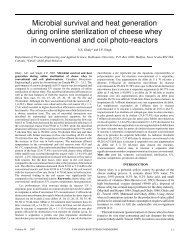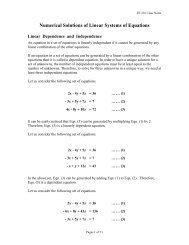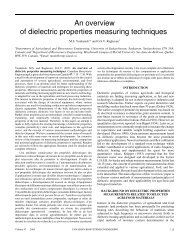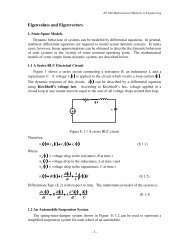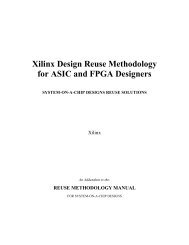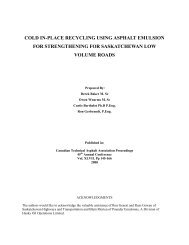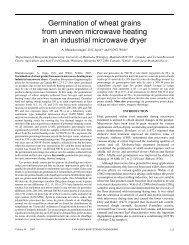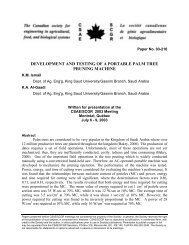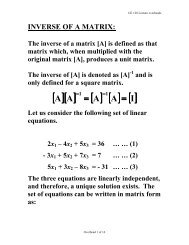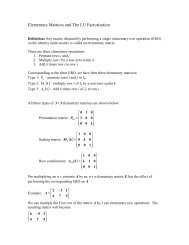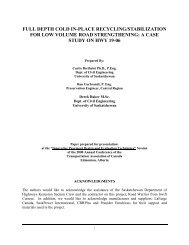436 Can. J. Civ. Eng. Vol. 30, 2003Table 4. Statistical parameters <strong>for</strong> <strong>the</strong> exposure coefficient, combined gust and pressure coefficients, and overall wind load trans<strong>for</strong>mation<strong>factor</strong> reported by o<strong>the</strong>rs.Source Bias CoV CommentExposure coefficient, C eAllen 1975 — — Bias = 0.85; CoV = 0.13 assumed <strong>for</strong> combination <strong>of</strong> C e C g andmodellingEllingwood et al. 1980 1.0 0.16 Exposure <strong>factor</strong> different from NBCCDavenport 1981 1.0 0.10 As reported by Kariyawasam 1996Davenport 1982 0.80 0.16 Low buildingsEllingwood and Tekie 1999 0.93 0.129 Low buildingDavenport 2000 0.80 0.20 For simplified method; tall buildingCurrent investigation 0.80 0.16Gust coefficient and pressure coefficient, C g C pAllen 1975 1.0 0.10 Pressure coefficient only; model error <strong>factor</strong> <strong>of</strong> 0.85 included separatelyEllingwood et al. 1980 1.0 0.11 Gust1.0 0.12 Pressure1.0 0.16 CombinedDavenport 1981 (as reported by 1.0 0.05 GustKariyawasam (1996))1.0 0.10 Pressure1.0 0.11 CombinedDavenport 1982 0.80 0.15 For low buildingsEllingwood and Tekie 1999 0.97 0.093 Gust0.88 0.067 Pressure (same nominal values as NBCC)0.85 0.115 CombinedDavenport 2000 0.80 0.21 For simplified method; tall buildingCurrent investigation 0.85 0.15Overall wind load trans<strong>for</strong>mation <strong>factor</strong>Allen 1975 0.72 0.174 Basis <strong>for</strong> <strong>calibration</strong> <strong>of</strong> NBCCEllingwood et al. 1980 0.85 0.239Davenport 1981 0.85 0.150 Not specifically <strong>for</strong> low buildings (as reported by Kariyawasam (1996))Davenport 1982 0.54 0.325 Low buildings; only external pressuresRosowsky and Cheng 1999 0.73 0.264 For low buildings, high-wind regionsEllingwood and Tekie 1999 0.70 0.208 Not specifically <strong>for</strong> low buildings; all <strong>factor</strong>s have normal distributionsDavenport 2000 0.57 0.250 Simple method0.71 0.150 Detailed method1.00 0.087 Wind tunnel and meteorological studyCurrent investigation 0.68 0.22 Log-normalvalues in Appendix C <strong>of</strong> <strong>the</strong> 1995 NBCC. Annual maximumsnow depth data were provided <strong>for</strong> 1278 data-collection sitesby <strong>the</strong> Engineering Climatology Section <strong>of</strong> <strong>the</strong> CanadianMeteorological Centre. The CoV <strong>of</strong> <strong>the</strong> annual maximumdepth ranges from 0.08 to 1.34, with a mean <strong>of</strong> 0.491 and amedian <strong>of</strong> 0.47. Approximately 95% <strong>of</strong> <strong>the</strong> CoV values liebetween 0.22 and 0.95. Statistical parameters <strong>for</strong> maximumsnow depth in a 50 year reference period are summarized inTable 5. The ratio <strong>of</strong> <strong>the</strong> mean value <strong>of</strong> <strong>the</strong> maximum depthin a 50 year reference period to <strong>the</strong> 1 in 50 year specifiedsnow depths were computed using eq. [7]. The ranges <strong>of</strong>bias coefficients and CoV values <strong>for</strong> <strong>the</strong> normalized maximum50 year distribution are quite small, so <strong>the</strong> valuesshown in <strong>the</strong> last row <strong>of</strong> Table 5 were adopted.Snow densities used to derive <strong>the</strong> 1 in 30 year valuesspecified in <strong>the</strong> 1995 NBCC were assigned based on <strong>the</strong>type <strong>of</strong> <strong>for</strong>est in <strong>the</strong> region <strong>of</strong> <strong>the</strong> site. Kariyawasam (1996)has summarized statistical parameters <strong>for</strong> snow density, ρ,from Newark (1984), as reproduced in Table 6. In <strong>the</strong>Table 5. Statistical parameters <strong>for</strong> maximum snowdepth in 50 year period.CoV a Bias CoVLower 3% fractile 0.220 1.064 0.132Mean 0.491 1.099 0.197Upper 3% fractile 0.953 1.126 0.244Current investigation 1.10 0.20current investigation snow densities were assumed normallydistributed with a bias <strong>of</strong> 1.0 and a CoV <strong>of</strong> 0.17. The CoVvalue adopted is <strong>the</strong> average <strong>for</strong> all regions except tundraand taiga, which are not densely populated.Associated rain loadThe associated rain load represents <strong>the</strong> weight <strong>of</strong> rain fallingon snowpack, and values <strong>for</strong> Appendix C <strong>of</strong> <strong>the</strong> 1995NBCC have been derived based on historical data <strong>for</strong> winter© 2003 NRC Canada
Bartlett et al. 437Table 6. Statistical parameters <strong>for</strong> snow density (Kariyawasam 1996).Forest region Mean (kg/m 3 ) SD (kg/m 3 ) CoV Typical sitesAcadian 220 50 0.23 Fredericton, Halifax, St. John’s, CharlottetownAspen grove 220 40 0.18 Edmonton, Saskatoon, Winnipeg, Thunder BayBoreal 190 60 0.32 Nor<strong>the</strong>rn Prairies, mid-nor<strong>the</strong>rn Ontario and QuebecCoast 430 25 0.06 Coastal British ColumbiaColumbia 360 35 0.10 Sou<strong>the</strong>astern British ColumbiaGreat Lakes 220 60 0.27 Sou<strong>the</strong>rn and central Ontario, sou<strong>the</strong>rn QuebecMontane 260 25 0.10 Interior British Columbia and YukonPrairie 210 40 0.19 Sou<strong>the</strong>rn Prairies, ReginaSubalpine 360 30 0.08 Vancouver and Fraser ValleyTundra 300 80 0.27 ArcticTaiga 200 80 0.40 Subarctic, YellowknifeCurrent investigation 0.17Note: SD, standard deviation.rainfall (Taylor and Allen 2000). Subjectivity was requiredin <strong>the</strong> process <strong>of</strong> sketching 0.1 kPa isolines on maps(Newark et al. 1989). The difficulty <strong>of</strong> deriving statisticalparameters <strong>for</strong> this load is fur<strong>the</strong>r exacerbated because <strong>the</strong>necessary data are not readily available and, even if <strong>the</strong>ywere, would require careful filtering to eliminate winterrainfall on nonexistent snowpacks. It was <strong>the</strong>re<strong>for</strong>e assumedthat probability distributions <strong>for</strong> <strong>the</strong> ro<strong>of</strong> snow load includeany fur<strong>the</strong>r bias and uncertainty due to <strong>the</strong> associated rainload.Ground-to-ro<strong>of</strong> trans<strong>for</strong>mation <strong>factor</strong>Although <strong>the</strong>re is a significant body <strong>of</strong> literature concerning<strong>the</strong> ground-to-ro<strong>of</strong> snow load trans<strong>for</strong>mation <strong>factor</strong>, fewstudies provide results in a <strong>for</strong>mat that is compatible withcode <strong>calibration</strong>. Ellingwood and O’Rourke (1985) cite <strong>the</strong>following relationship, from O’Rourke et al. (1982):[10] Cgr = 047 . ETεwhere E is a wind exposure <strong>factor</strong> ranging from 0.9 to 1.3; Tis a <strong>the</strong>rmal characteristic <strong>factor</strong> ranging from 1.0 to 1.2; andε is <strong>the</strong> error term, which has a log-normal distribution witha mean value <strong>of</strong> 1.0 and a CoV <strong>of</strong> 0.44. The trans<strong>for</strong>mation<strong>factor</strong> computed using eq. [10] ranges from 0.53 to 0.91times <strong>the</strong> basic ro<strong>of</strong> snow load <strong>factor</strong> <strong>of</strong> 0.8 specified in <strong>the</strong>1995 NBCC.For <strong>the</strong> present investigation, parameters were adoptedfrom a recent study by Taylor and Allen (2000) that are consistentwith <strong>the</strong> definition <strong>of</strong> <strong>the</strong> ground-to-ro<strong>of</strong> snow load<strong>factor</strong> as defined in eq. [8]. Various results, summarized inTable 7, consider <strong>the</strong> ratio <strong>of</strong> <strong>the</strong> maximum measured ro<strong>of</strong>snow load to <strong>the</strong> corresponding maximum ground snow loadas converted to an equivalent ro<strong>of</strong> load using <strong>the</strong> NBCC criteria.The statistics are based on 13 years <strong>of</strong> data <strong>for</strong> 112ro<strong>of</strong>s in four Canadian cities. The bias <strong>for</strong> data obtainedin Halifax, Chicoutimi, and Ottawa and <strong>the</strong> drift locationin Saskatoon tend to fall within <strong>the</strong> ranges suggested byEllingwood and O’Rourke (1985). The CoV values are alsosimilar.Point-in-time snow loadPoint-in-time snow load parameters were derived assumingthat <strong>the</strong> snow accumulation is a stochastic process andTable 7. Statistical parameters <strong>for</strong> ground-to-ro<strong>of</strong>trans<strong>for</strong>mation <strong>factor</strong> (Taylor and Allen 2000).<strong>the</strong> <strong>factor</strong>s that trans<strong>for</strong>m <strong>the</strong> depth to a load and <strong>the</strong> groundsnow load to a ro<strong>of</strong> snow load are time-independent randomvariables. It was assumed that <strong>the</strong> point-in-time pulse has amagnitude that follows <strong>the</strong> Weibull distribution and a duration<strong>of</strong> 14 days during only 3 months <strong>of</strong> <strong>the</strong> year, so <strong>the</strong>reare six events per year. The central tendency and dispersion<strong>for</strong> <strong>the</strong> point-in-time distribution represent a bias with respectto <strong>the</strong> specified 1 in 50 year snow depth <strong>of</strong> 0.196 and aCoV <strong>of</strong> 0.882.Summaryn Bias CoVSheltered locationsHalifax 35 0.61 0.45Chicoutimi 8 0.71 0.44Saskatoon 8 0.30 0.11Recommended value 0.60 0.42Exposed locationsHalifax 11 0.47 0.46Ottawa 12 0.44 0.41Saskatoon 5 0.33 0.22Recommended value 0.50 0.42Drift locationsChicoutimi 4 0.86 0.30Ottawa 6 0.60 0.38Saskatoon 23 0.61 0.43Recommended value 0.60 0.42Current investigation 0.60 0.42Note: n, number <strong>of</strong> ro<strong>of</strong>s in <strong>the</strong> sample.This paper summarizes statistical parameters <strong>for</strong> deadload, live load due to use and occupancy, snow load, andwind load that have been adopted <strong>for</strong> <strong>calibration</strong> <strong>of</strong> load andload combination criteria <strong>for</strong> <strong>the</strong> <strong>2005</strong> <strong>National</strong> BuildingCode <strong>of</strong> Canada (NBCC). Table 8 summarizes <strong>the</strong> bias andCoV values and distribution types adopted <strong>for</strong> <strong>the</strong> <strong>calibration</strong>presented in a companion paper. A new survey <strong>of</strong> typicalconstruction tolerances indicates that statistical parameters<strong>for</strong> dead load presented by Ellingwood et al. (1980) are ade-© 2003 NRC Canada



